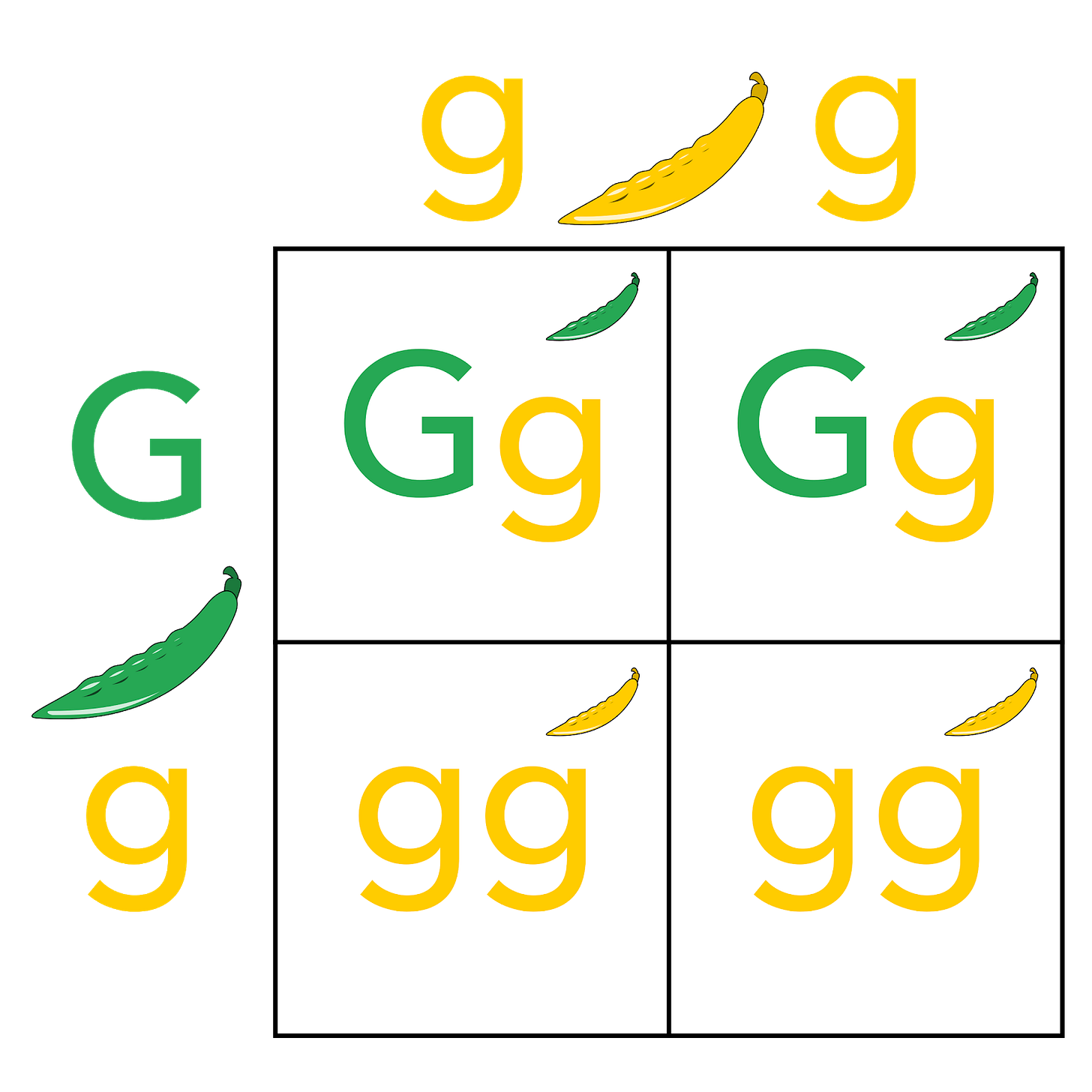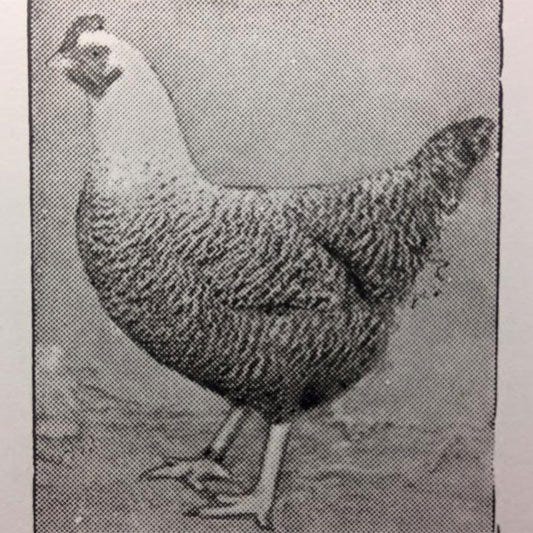Why is this interesting? - The Chicken Sexing Edition
On genetics, farming, and the incredible power of intuition
Noah here. If the name Punnet rings a bell, it’s probably from high school biology class. Punnet Squares are the four-box diagrams that were used to explain dominant and recessive genes. They look something like this:

The guy behind them was named Reginald Punnett. He was a British geneticist and professor and, of interest to me, the inventor of a breed of auto-sexing chickens. It turns out it’s hard to discern the sex of chickens at birth, which is obviously important if you’re raising the birds and want to focus on egg-layers. Punnet, with his understanding of genetics, had a theory that he could cross breeds and use the resulting plumage patterns to distinguish between males and females. After World War I, he received backing from the National Poultry Institute in the UK and started working on an “auto-sexing” chicken. He introduced the Cambar and later the Legbar chicken breeds, which both allowed for easy distinguishing between males and female chicks using the patterns in their plumage.

The Cambar
Unfortunately, Punnet’s chickens didn’t have some of the qualities farmers were looking for, and plumage-based auto-sexing lost out to a different method of distinguishing the sex of chicks. Here’s how it was described in Punnet’s Royal Society biography from 1967:
The production of these auto-sexing breeds was a fine piece of biological engineering; they would certainly have been of very great value to the poultry industry had not the 'Japanese' method of identifying the sexes in newly-hatched chicks by examination of the cloaca been introduced about this time. This method is a very ancient one long practised in China and Japan and can be used in the established pure breeds so that interbreed crosses, which are greatly disliked by many poultry breeders, can be avoided.
Why is this interesting?
It’s one hundred years on from Punnet’s Cambar, and we still haven’t figured out a great way to discern the sex of baby chickens. Here’s the opening to a fantastic Pacific Standard article on the subject from 2018:
"A chicken," says Jacqueline Jacob, a poultry science expert with the University of Kentucky, "does not have a penis." With this choice anatomical fact clarified, the context was set for me to better understand the egg industry's greatest logistical challenge, one that is faced seconds after a chick hatches: determining its sex. Virtually every link in the supply chain for hens, from genetics to the size and color of their eggs, is measured and automated with obsessive precision. The egg industry in the United States depends on streamlined industrialized efficiency—agricultural economists call it an "egg complex"—to generate over 100 billion eggs from more than 370 million hens a year. It does so through highly consolidated operations that house, in most cases, over a million birds at a time, relying on advanced technological systems for everything from collecting to washing to grading and sorting. It's an ambitious endeavor that ranks the U.S. behind only China as the largest egg supplier in the world. Yet the most essential element in this massive and mechanized operation—figuring out if the hatched bird is biologically suited to lay eggs—relies on the vagaries of human eyesight. A chicken sexer—the industry's secret weapon—eyeballs the nearly identical genitalia of male and female hatchlings and, in an instant, makes the call.
The giant poultry industry runs on the abilities of these “sexers.” And the best are amazing at their jobs: able to sort one thousand chicks-per-hour with 98% accuracy. They do this by examining the chicks vents, a hole that handles both waste and egg-laying. Where things get weird is that sexers can’t explain exactly what they’re looking for once they get eyes on the underside. The magic of chicken sexing is that it’s almost entirely instinctual. Here’s how Joshua Foer described it in his book Moonwalking with Einstein:
“What makes chicken sexing such a captivating subject—the reason that academic philosophers and cognitive psychologists have authored dissertations about it, and the reason that my own research into memory had brought me to this arcane skill—is that even the best professional sexers can’t describe how they determine gender in the toughest, most ambiguous cases. Their art is inexplicable. They say that within three seconds they just “know” whether a bird is a boy or a girl, but they can’t say how they know. Even when carefully cross-examined by researchers, they can’t give reasons why one bird is a male and another is female. What they have, they say, is intuition. In some fundamental sense, the expert chicken sexer perceives the world—at least the world of chicken privates—in a way that is completely different from you or me. When they look at a chick’s bottom, they see things that a normal person simply does not see. What does chicken sexing have to do with my memory? Everything.”
In some ways, chicken sexing belongs in the same category as riding a bike (or, according to some, oyster shucking): You can’t ever really learn how to do it; you can only learn to do it. This sort of problem—distinguishing the instinctual patterns seen only with the greatest expertise—seems like a perfect match for machine learning, so I wouldn’t be surprised if someday in the future we saw chicken sexers sadly lose their jobs to computers. But for now, instinct appears to be more effective than any algorithm. (NRB)
Newsletter of the Day: First Floor
Shawn Reynaldo is a longtime music and culture journalist focused on electronic music. He’s also been a gigging DJ in SF, where he got his start, Barcelona, where he now resides, and around the world. Formerly, editor of the iconic music mag XLR8R, Shawn started First Floor a year ago to document dance music from multiple angles (including the hardships of COVID for artists and performers). But I also like how he spends a ton of time sifting through new records and linking out to really good stuff on Bandcamp. An added bonus is his wife Dania, who always includes her selections, which skew more experimental, leftfield, and always interesting. He’s moving toward a paid model, which I recommend, but if on the fence, it’s worth skimming through the archive to see the amount of effort he puts into the publication and how important it has become to the scene. (CJN)
Quick Links:
Every story from Zeynep Tufecki about COVID has been a must-read. Her latest is on why just focusing on R0, a rate of contagiousness, misses the picture of k, which essentially looks at “whether a virus spreads in a steady manner or in big bursts, whereby one person infects many, all at once.” We are dealing with a big burst virus, and that requires rethinking a bunch of wisdom. (NRB)
I love stories like this: ‘A Million Random Digits’ Was a Number-Cruncher’s Bible. Now One Has Exposed Flaws in the Disorder. (NRB)
Thanks for reading,
Noah (NRB) & Colin (CJN)
PS - Noah here. My company, Variance, is looking for a lead product designer (remote) to join the team. If that’s you or someone you know, please be in touch.
—
Why is this interesting? is a daily email from Noah Brier & Colin Nagy (and friends!) about interesting things. If you’ve enjoyed this edition, please consider forwarding it to a friend. If you’re reading it for the first time, consider subscribing (it’s free!).


